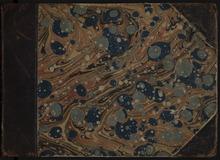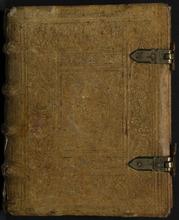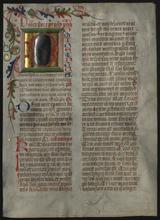1 - 3 of 3 records
[Lace pattern book.]

Description: The book was captured in the reoriented direction done "shortly before 1700" (see details in notes below).nn…with additions 1688–1701]. Oblong 2° (22 . 31 cm). An album of pre-printed red grids (printed on 1 side of each leaf ) mostly of 101 . 161 squares, each grid square measuring about 1.67 . 1.67 mm, with every 10th square marked the along the edges by 2 gridlines extending about 1 grid length into the margin, used as intended to make manuscript needlework patterns by putting a black ink dot in each square that is supposed to be filled. What was originally the first leaf (the only folding leaf ) has been constructed by pasting together about 2/3 of two different grid leaves before the pattern was filled in. Of the 50 grid leaves, 49 were probably printed ca. 1600, while the present leaf 1 along with 6 smaller pieces of grid paper mounted on the unprinted sides of leaves 1 and 2 were probably added ca. 1700. Half brown sheepskin with a morocco grain (England, ca. 1855/65). With the original ca. 1600 brown paper wrappers bound innn"A ca. 1600 pattern book, probably intended for lace, embroidery and perhaps weaving and other applica¬tions. It was produced as an album of grid paper, most leaves with a red grid of 101 . 161 squares, where the user could make patterns by filling in some squares with a black dot and leaving others blank.nnIn its original orientation, the album began with the folding leaf followed by 48 leaves. The first owner or user of the album probably filled most of the leaves with patterns soon after it was produced ca. 1600. The paper of the grid leaves and the white paper core of the brown paper wrappers was made in Augsburg around 1600 (see below) and the frequent use of pinecone motifs in the pattern designs suggests that the book was not only printed but also used in Augsburg.nnShortly before 1700, someone began using the album again, turning it over and pasting a pink label with the date "Ao 1699" to what had been the back wrapper, making it the front wrapper. This was probably Anna Catharina von Knoll, who inscribed her name twice on the inside of what had become the front wrapper.nnWith an inscription, probably an owner's name, erased and illegible, on the inside of what was orig¬inally the front wrapper. The 1707 inscription by Anna Catharina von Knoll, noted above, gives her name twice.nnWith marginal restorations, 1 with the loss of the corner of the grid but apparently no loss to the pattern, minor and mostly marginal foxing, and an occasional small ink spot, abrasion or transparent stain. The binding has cracks in the hinges and some abrasions. Although the book certainly shows signs of use, most of the patterns survive complete and in good condition. A remarkably early Augsburg pattern book for lace and needlework, with the patterns rendered with a pen and black ink on preprinted red grids.nn[50], [1 blank] ll. with 6 pieces mounted on leaves 1 & 2. Sotheby, Cat. of the first portion of the library of the late Edward Hailstone (4–14 February 1891), lot 1195? (not seen); for (mostly printed) pattern books in general: Early modern embroidery and lace pattern books; Arthur Lotz, Bibliographie der Modelbücher."nnFull pdf available, https://dl.mospace.umsystem.edu/mu/islandora/object/mu%3A447498/datastream/PDF/view
Resource Type: Text
Breviary, Benedictine use.

Description: "Manuscript on vellum, Benedictine prayer book. Ff. 90. Augsburg or its environs, a collection of various parts ranging in date from the later 15thcentury till c. 1530. Written in brown, black and red ink in various hands, 18 to 25 lines per page, and with four illustrations, bound in blindstamped pigskin over wooden boards with two brass clasps, ca. 1530-40, the stamps represent medallion heads of warriors and floral ornaments, central emblem with remains of gilding on front cover, depicting a round object (a helmet?) at the top, the rounded tip of a crosier to its right, all placed on a tree trunk resting on a skull and flanked by two cocks emblem and some other parts rubbed and worn, some minor cracks in spine, but nevertheless a well-preserved and completely unrestored binding, (c.9,5 x 7,5 cm) Contents: Ff 1-14: Calendar, black and red ink, ca. 1500, including two blanks and one leaf for each month (most of them slightly shaved at top); gives feast days, both common and local, and symbols indicating moon phases, Local saints named point to Augsburg: Saints A(u)fra, Vodalricus, Erhardul, Colomannus, Wolfgangus, Othmarus, Cunradus are mentioned, as well as under Sep. 28 apparently the anniversary of the Augsburg cathedral, 'Dedica(ti)o cat(hedralis) Augs(burgiensis)', several corrections and additions to entries; the names of some saints, such as Thomas Aquinas, have been erased, though no explanation for this is evident, the calendar is clearly Benedictine (St. Benedict is thus the only saint of the calendar for whom both his feast day and his octava is entered), on the back of last leaf is a heraldic drawing in ""fake"" gold ink (now mostly oxidised into a green colour) representing a coat of arms divided diagonally into a field of horizontal stripes to left and a cock to right, all surmounted by a closed feathered helmet with a sword to its left and a crosier to its right; above the date ""MCCCC"" (1400: date of granting of arms?), the cock obviously suggest the coat of arms to be that of the Beno von Rothenhan mentioned later in the book; likewise, the gilt emblem with cocks on the book's cover must represent this man. The calendar is followed by prayers, psalms and hymns (beginning: ""Incipit accesue altarie""), written by various hands (at least 13 different ones can be identified), including that of the calendar, with portions of text erased or replaced in several places, on 29v an early engraving, ca. 1500, (worn and abraded) on paper, representing the Ascension of Mary Magdalene assisted by six angels, and hand-coloured in red, green and yellow, has been glued onto the page, the image is accompanied by biblical passages on and prayers to Mary Magdalene among others, on 32v a miniature (ca. 1530-40?) is painted in rather pale colours (yellow, reddish brown, brown, light violet and orange): Madonna with child in a roundel enclosed in a large ""M"", on f 46r is a monogram crowned by a seven-spiked baronet's (Freiherr) crown, below which is written the name Beno v(on) Rothenhan (ca. 1530?), on f 88r is mentioned indulgences granted by Pope Nicolas, no doubt in connection with the small jubilee of 1450.nnThe collation of the book is extremely complex; apparently the owner, Beno von Rothenhan, of the various pieces in the volume had them assembled and bound for his personal use, we have unfortunately not been able to trace Freiherr Beno von Rothenhan, fl. ca. 1530 at (or around) Augsburg; the family is found in Siebmacher's Wappenbuch, vol. 22, p. 20 & 54 with pl.s. 14 & 56, though the coat of arms illustrated there only has the image of a cock in common with that in our book. All the pieces represent Roman-Catholic orthodoxy, and none of the numerous erasures in the book seems explicable in terms of the religious struggles of the time.",Full pdf available, https://dl.mospace.umsystem.edu/mu/islandora/object/mu%3A445368/datastream/PDF/view
Member of: Private Collection of Antiquarian Books and Manuscripts
Resource Type: Text
Missal [leaf].

Description: Manuscript folio. Written in Gothic textualis script on parchment with decorated capital "D" (9 lines tall), with foliage extending into the margin, in red, blue, green, pink brown and white ink, and also gold and (tarnished) silver. Page from a missal. The text is arranged in two columns (34 lines). As a heading to the page, and rubricated, the Roman numeral: CXVI. The beginning of the passage reads: "Domine lingua mia iraui exultavit cor meu in salutari tuo cantabo domino qui bona tribuit mihi" (a section comes from Psalm 12:6 "Exsultabit cor meum in salutari tuo. Cantabo Domino qui bona tribuit mihi"). The text includes rubricated phrases and initials, as well as a capital "D" in blue ink. 34.7 x 25.2 cm
Member of: Private Collection of Antiquarian Books and Manuscripts
Resource Type: Text